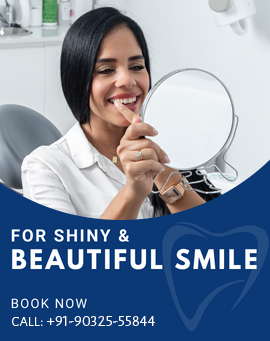10:00 AM to 8:30 PM (Mon - Sat)
10:00 AM to 2:00 PM (Sunday)
How to Choose a Toothbrush

The Importance of Choosing the Right Toothbrush
Do you know that an average person spends about 924 hours of their life brushing their teeth? This clearly states how important brushing your teeth is, but with a plethora of options available in the market, how to know which one is right for you? Through this blog, we will help you understand what an ideal toothbrush should be like, and how to select one.
1. Bristle Type:
Do you know why our teeth get cavities? This is because of plaque, which is nothing but a sticky film of bacteria that builds on teeth. The bacteria present in this plaque feed on the sugar & starch from the food that we eat and produce acid. This acid takes away the enamel and becomes a breeding ground for cavities to grow.
The removal of plaque and tartar (hardened plaque) is possible only when we use a toothbrush with soft bristles. Dentists recommend soft bristles because these brushes are proven to give effective results from tooth decay and gum diseases.
Now that you know the importance of soft bristles, understand why not use a brush with medium or hard bristles. It is observed that long use of medium/hard bristles can lead to gum recession and tooth sensitivity. Eventually, this erodes teeth enamel and makes your teeth more vulnerable to cavities.
2. Head Size:
The smaller the better! When the toothbrush’s head is small, your brush gets a better scope to reach all tricky areas of the mouth. Especially, the back teeth, which do the hard work of chewing.
3. Handle Design:
Do you know there are three types of brushing techniques, viz. Bass Technique, Stillman Technique, and Charter Technique. The Bass & Stillman techniques provide better cleaning and are effective in plaque removal, whereas, the Charter technique is for the one who has gaps in the teeth or has gum-related problems.
Now to follow these techniques, it must have a brush handle that is comfortable and ergonomic. Such handles provide a non-slip grip and better control and also make sure that your toothbrush has a flexible neck to reach difficult areas of the mouth.
4. Electric Toothbrush:
Electric toothbrushes are expensive but are popularly known for removing plaque. New and modern electric toothbrushes come with timers to ensure you brush for two minutes. Some toothbrushes even have quadrant timers that remind you to move to a different area of your mouth every 30 seconds. The best part is that it comes with pressure sensors. These sensors send an alert when the person is brushing too hard.
5. Special Features:
A lot of toothbrushes come with an in-built abrasive texture for tongue cleaning. It’s a good idea to have these brushes at your disposal when you are travelling and you do not want to carry a tongue cleaner separately. Another feature manual brushes have these days are angled bristles, these bristles are effective in cleaning, especially along the gum line.
Conclusion:
Toothbrush has a lot more potential than you can think, if you brush properly and diligently, you can save your multiple dental visits. As dentists say, floss once a day and brush twice a day- only this way you can keep cavities at bay! Remember, brushing can be challenging if you have braces, implants, or other dental procedures going on, consult a dentist and understand which type of brush is the best for you in such scenarios. You can consult the dentists of Yashwanth’s Lotus Dental Clinic- the best dentist in Vijayawada.


